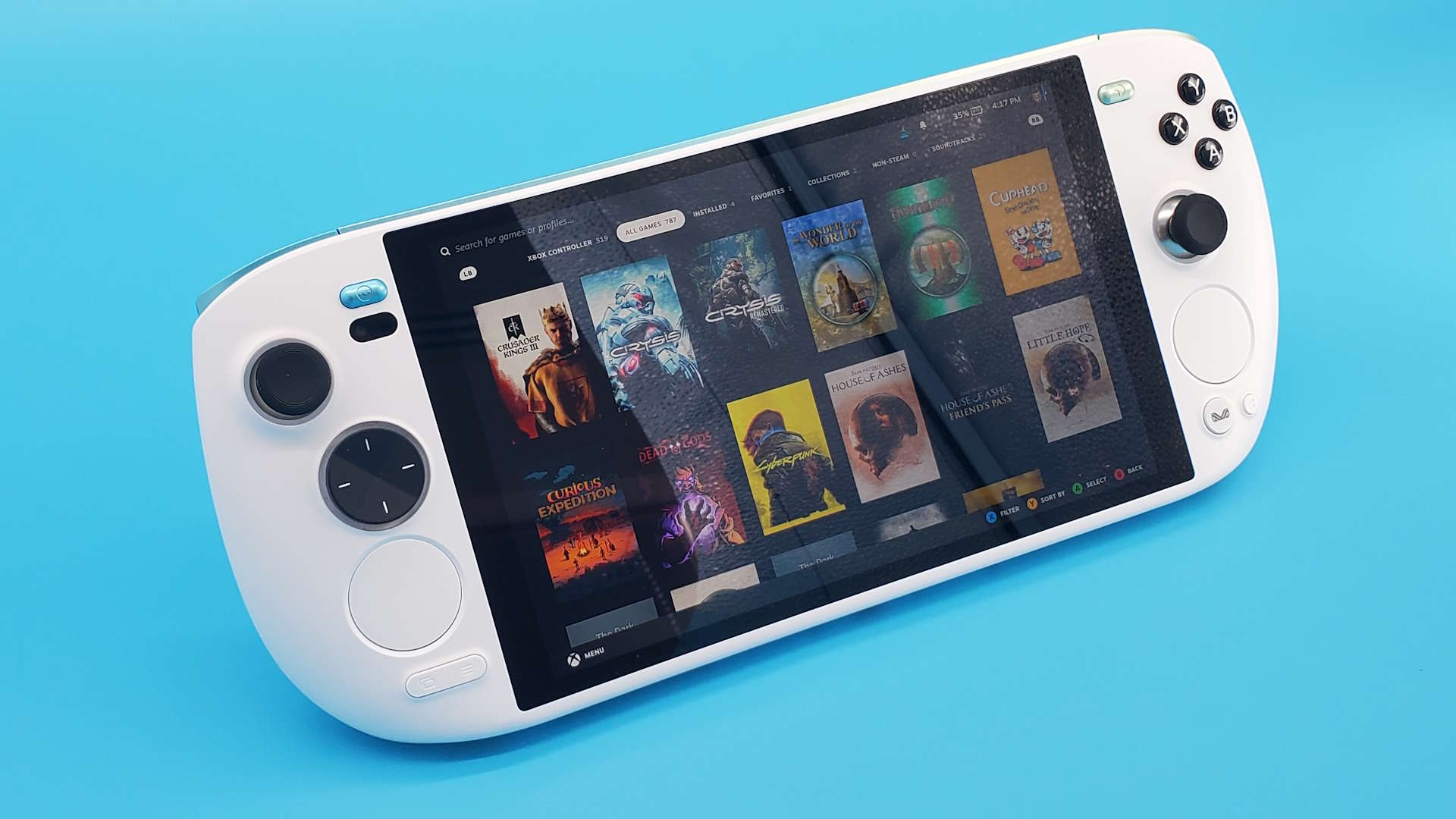
Physically wonderful, technically impressive, frustratingly quirky.
The Ayaneo Kun is almost the king of handheld gaming PCs. I mean, that’s what the company has been aiming for with a name like that, and it gets so damned close, but there are the little things that get in the way of me giving it an unreserved recommendation as the absolute best.
Having to almost completely strip it down to replace a tiny rubber grommet being just one of the things that have given me pause in my time testing the mighty minty-highlighted device. Then I pick it up again, its big bright screen beaming up at me, its pleasing curves nuzzling into my grip, and I get back to playing my PC games on a setup that feels more truly mobile than any gaming laptop I’ve used.
One of the things I’ve enjoyed watching going on in the handheld market over the past 12 months has been the level of tinkering companies have done to create a host of different devices essentially based upon the exact same silicon. The AMD Ryzen 7 7840U (and occasionally the Ryzen Z1 Extreme) chip has been the SoC de jour for almost all the handhelds you can buy right now. We are starting to see some Intel Meteor Lake based offerings, but largely AMD has the monopoly on your handheld hardware.
So, manufacturers have done other things. Ayaneo itself has a host of different devices, from the tiny Air 1S, to its Flip in two different designs, and the Slide. Perhaps the Kun is the most traditional of the lot, but it has its own claims to innovation, the unique 54W mode on its 30W APU being but one of them. It’s also chonking big, with a large 8.4-inch screen, though in a Steam Deck-y way it still feels good in the hand and I’ve spent many an hour lying in bed playing Baldur’s Gate 3 on this gorgeous machine without my hands dropping off.
(Image credit: Future)
APU: AMD Ryzen 7 7840U
iGPU: Radeon 780M
Memory: 16|32|64GB LPDDR5-7500
Storage: 512GB|1TB|2TB|4TB SSD
Screen: 8-inch IPS
Resolution: 2560 x 1600
Battery: 75Wh
Price: $1329 (32GB/2TB unit)
It’s also the only handheld I’ve seen so far to pick up Valve’s use of twin trackpads and run with it. The size of the Kun means it can get away with sticking two pads, one below the left D-pad and the other under the right-hand thumbstick. At first they were all kinds of unusable, but a recent update has made the trackpads far more responsive and much more like the sort of pad you’d find on a laptop. Just, y’know, really small.
When you’re using a Windows-based handheld they come in very handy just for ease of navigation in those awkward launchers that resolutely adhere to the idea that if you’re playing a PC game then you’re going to be using a mouse as your primary input no matter what. I get it, I love a good gaming mouse, too, but it does make the handheld gig a tougher one.
The core spec itself is impressive; alongside the ubiquitous Ryzen 7 7840U and its 780M iGPU, I’ve got 32GB of LPDDR5-7500 and a 2TB Lexar SSD, and that gives me an eight-core, 16-thread machine with the heart of a seriously powerful PC. That’s not necessarily what you want from a handheld gaming PC where the priorities are more around portability and battery life than straight line performance—just ask the Steam Deck OLED—but Ayaneo has jammed a hefty battery into the Kun, too.
That means we’re able to get within a slice of silicon of two hours in the PCMark 10 gaming battery life test, even running the machine at 30W.
In terms of gaming performance, however, I was maybe hoping for a bit more. Ayaneo has made a lot out of its cooling and its mega 54W TDP limits, but no matter what I’m never getting industry-leading gaming performance out of the device. Even against handhelds with the same essential core spec, such as the OneXPlayer 2 Pro, it’s generally in the lead.
It’s up there for sure, and optimising the game settings will get you impressive 1080p gaming performance—and very occasionally passable 1440p frame rates—but never the outright best.
(Image credit: Future)
(Image credit: Future)
(Image credit: Future)
(Image credit: Future)
Where it is outright best, however is in the config software. Ayaneo also has the absolute best software for handheld PC control out there, even compared with the deep integration Valve has between SteamOS and Deck. That allows you to tailor your experience depending on what you’re playing in order to squeeze as much battery life out of the Kun as possible while still enjoying a healthy frame rate.
If I want the full power of the AMD APU I can leave it at 30W and push the Radeon 780M graphics chip to its maximum, or if I’m bounding around the Sword Coast via GeForce Now I can drop it down to a measly 5W TDP and have the battery last for an age.
Though, if you want the FULL power of the AMD APU Ayaneo gives you that 54W mode… which I cannot in all good conscience recommend. Not for the fact it hoses through your battery, or gets toasty doing it, but because it does nothing. Well, nothing good. If there were instances where you got another 10% performance it would have been a great docked mode you could deal with when plugged into the wall, but it doesn’t. Occasionally I’ve seen a handful of frames per second extra for going balls to the wall in terms of jamming power into the Ryzen silicon, but more often than not by gaming benchmarks went backwards when I pushed it into what I’d dubbed ‘Extreme’ mode in the AyaSpace app.
(Image credit: Future)
(Image credit: Future)
(Image credit: Future)
My first impression of getting it out of the gorgeous packaging was: “Wow.” My second was: “That D-pad is sticky and gross.”
I also found it left the device in a rather fragile state, functionality wise. I seemed to suffer more instability and flakiness when I was switching between the 54W mode and more sensible presets. In the end I’ve renamed it from ‘Extreme’ to ‘Unwise’ and probably won’t be using it again.
Which is a shame, as on the whole the device itself is a pleasure to use and I was hoping for some serious performance gains. It feels great in the hand—though messing around with my Steam Deck OLED again recently reminded me how well balanced Valve’s machine is—and its standard performance excellent. It’s a handheld that almost has the perfect premium aesthetic. I love the way it looks… but there are definite things that let it down.
The most obvious is the damn D-pad. My first impression of getting it out of the gorgeous packaging was: “Wow.” My second was: “That D-pad is sticky and gross.”
✅ You want a big-screen handheld: The Kun is big, but actually quite beautifully formed. The 2560 x 1600 resolution’s a bit much for the 780M iGPU, but the 8-inch scale isn’t and it’s a delight to game on.
✅ You’re after a good-looking device: I mean, c’mon, it’s a real looker. Especially in that white with blue-fading-to-green highlights. Yum.
❌ You’re expecting perfection: At this price, you kinda should be and there are annoying quicks which still niggle down the line.
❌ You were expecting that 54W mode to slay: It doesn’t deliver the extra performance I was hoping would put it head and shoulders above the competition in gaming terms.
In fact the D-pad is so sticky Ayaneo has had to issue a fix because of “a manufacturing defect in the gasket.” And that necessitates almost entirely stripping down your device to get at the back of the D-pad to replace the little rubber discs that sit below the actual rocker itself. Ayaneo is sending the fix out to anyone affected, which is great, but it does take a lot of dismantling that I can see people being uncomfortable about doing with their $1,300+ machine.
Though it does give you a good look at its insides, and it looks just as premium from that angle, too. I just wish the D-pad wasn’t still so damned sticky even after all that fiddling around.
And, while the 2560 x 1600 screen is very bright there is a certain lack of colour to it, which has had me digging into the Radeon settings to boost the saturation a bit to compensate. It’s also just a 60Hz panel, which certainly helps with battery life, but not the premium aesthetic.
It’s those little frustrations, and the flakiness seemingly inherent with the 54W mode, which means I can’t quite give it the glowing recommendation as the ultimate premium handheld of today I was expecting when I first started playing with it. It’s still a great device, with absolutely the best Windows software of any handheld around, and it’s one I will continue using. But Ayaneo is asking you to swallow a few very persistent foibles along with its high price tag, and I want it to be perfect for that sort of money.




